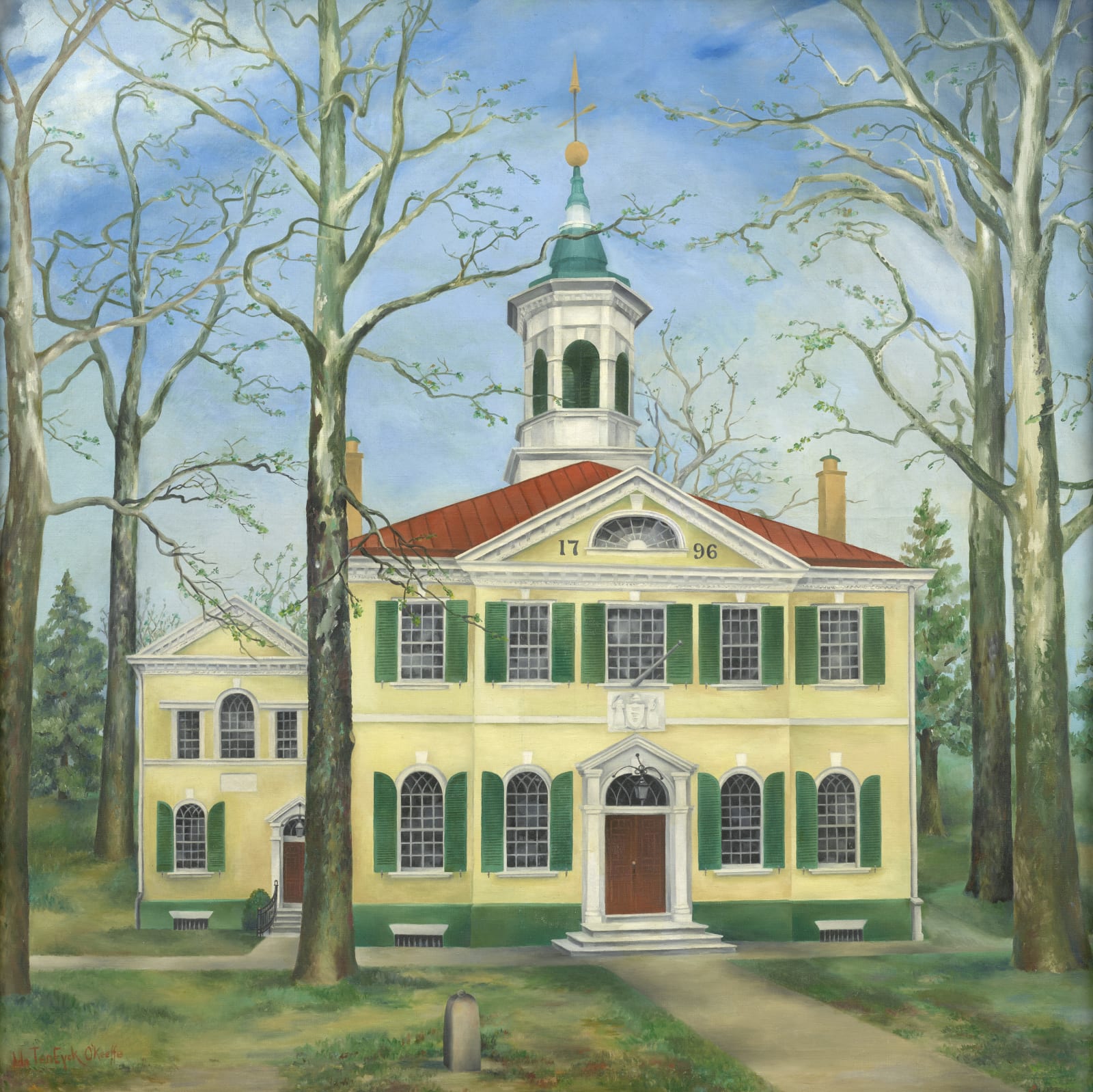Ida O'Keeffe
The County Seat, 1941
Signed at lower left: Eda Ten Eyck O'Keeffe; titled on verso: The County Seat; signed and dated on verso: Ida Ten Eyck O'Keeffe / 1941
Oil on canvas
48½ x 48½ inches
123.2 x 123.2 cm
123.2 x 123.2 cm
Although Ida O’Keeffe did not enjoy the widespread fame of her sister Georgia, her talent was praised by contemporary critics and her significant contributions were recently brought to light in...
Although Ida O’Keeffe did not enjoy the widespread fame of her sister Georgia, her talent was praised by contemporary critics and her significant contributions were recently brought to light in a retrospective at the Dallas Museum of Art organized by curator Sue Canterbury titled, Ida O’Keeffe: Escaping Georgia’s Shadow (2018). A gifted artist from a young age and trained as a nurse, Ida embarked on a serious painting career in 1925 at the age of 35 prompted in part by Georgia’s success along with the encouragement of her art dealer-husband Alfred Stieglitz. Just two years later, Ida exhibited at the Opportunity Gallery group show organized by Georgia, under the surname Ten Eyck to distance herself from her sister. The familial support ceased around 1933 when Georgia’s marriage and career began to fall apart but Ida was undeterred in the pursuit of her own artistic identity. Ida found time for her art while supporting herself through a myriad of teaching and nursing jobs, which caused her to move frequently to find new work. In 1940, she accepted the appointment as an art teacher for the Mount Holly schools in New Jersey, where she completed The County Seat in 1941.
Painted in a rare, large-scale square format to suit the dignified subject, the present work faithfully records the Mount Holly courthouse building, which is one of the oldest active courthouses in the country and the county seat for Burlington County. The landmark structure was built by the Quakers in 1796 and modelled after Philadelphia’s twin buildings Congress Hall and Old City Hall, which stand on either side of Independence Hall. O’Keeffe uses a highly detailed yet simple style that appears to the viewer as a historical painting but also firmly belongs to the modernist movement, which revived an interest in the folk art tradition. The unique hand-hooked wool frame is original to the painting, and was created by a Mount Holly resident that O’Keeffe commissioned. As Canterbury notes, “One of its more distinguishing traits is the row of stars across the top of the frame—a detail reminiscent of the tin stars she placed on the frame for Star Gazing in Texas (Dallas Museum of Art) three years before. In this case, the thirteen stars most likely referenced the original thirteen colonies” (Ida O’Keeffe: Escaping Georgia’s Shadow, 2018, p. 84). The stars call to mind Grant Wood’s use of this patriotic symbol on frames he designed for pictures like American Gothic (1930; Art Institute of Chicago) and Parson Weems’ Fable (1929; Amon Carter Museum of Art). Similarly, O’Keeffe’s precise rendering of the courthouse relates to the examples of American architecture featured in Wood’s work and the American values they represent. By 1943, O’Keeffe relocated to another Quaker community in Whittier, California, and donated The County Seat to the Veterans of Foreign Affairs there in 1959.
Painted in a rare, large-scale square format to suit the dignified subject, the present work faithfully records the Mount Holly courthouse building, which is one of the oldest active courthouses in the country and the county seat for Burlington County. The landmark structure was built by the Quakers in 1796 and modelled after Philadelphia’s twin buildings Congress Hall and Old City Hall, which stand on either side of Independence Hall. O’Keeffe uses a highly detailed yet simple style that appears to the viewer as a historical painting but also firmly belongs to the modernist movement, which revived an interest in the folk art tradition. The unique hand-hooked wool frame is original to the painting, and was created by a Mount Holly resident that O’Keeffe commissioned. As Canterbury notes, “One of its more distinguishing traits is the row of stars across the top of the frame—a detail reminiscent of the tin stars she placed on the frame for Star Gazing in Texas (Dallas Museum of Art) three years before. In this case, the thirteen stars most likely referenced the original thirteen colonies” (Ida O’Keeffe: Escaping Georgia’s Shadow, 2018, p. 84). The stars call to mind Grant Wood’s use of this patriotic symbol on frames he designed for pictures like American Gothic (1930; Art Institute of Chicago) and Parson Weems’ Fable (1929; Amon Carter Museum of Art). Similarly, O’Keeffe’s precise rendering of the courthouse relates to the examples of American architecture featured in Wood’s work and the American values they represent. By 1943, O’Keeffe relocated to another Quaker community in Whittier, California, and donated The County Seat to the Veterans of Foreign Affairs there in 1959.
Provenance
The artist; toWhittier Veterans of Foreign Wars, Whittier, California, 1959;
[Christopher English, Florida]; to
Private collection, Dallas, 2009-2021
Exhibitions
Patriotic Hall, Whittier Veterans of Foreign Wars, California, 1959Lincoln Glenn, New York, National Association of Women Artists (NAWA): A 135th Anniversary, March 28–May 31, 2024
Literature
"Local Artist Gives VFW Post Historic Painting," The Whittier News, November 6, 1959, p. 6, illus.Jennifer Alexander, "The County Seat," Art of Rug Hooking, February/March 2018, pp. 26-28, illus. p. 27
Sue Canterbury, et al., Ida O’Keeffe: Escaping Georgia’s Shadow, Dallas Museum of Art, 2018, p. 84, fig. 37, illus. in color p. 83
Roz Akin

